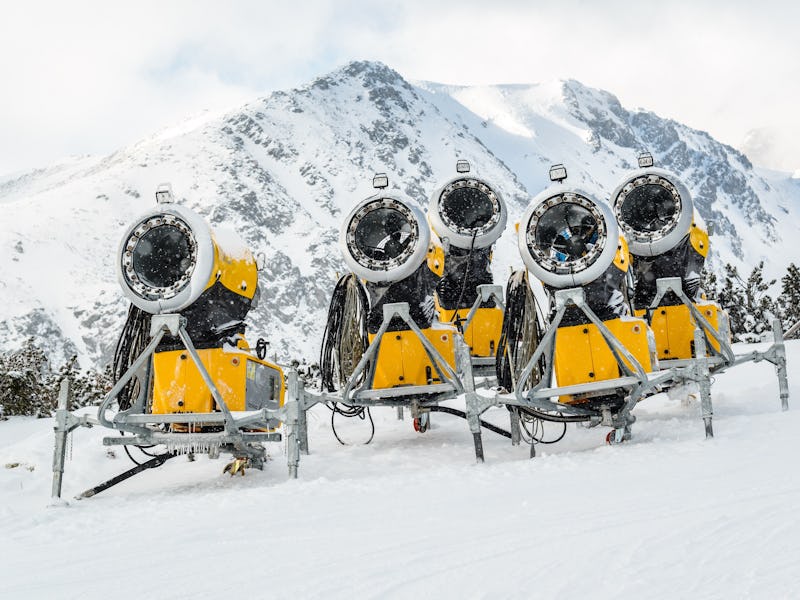A Weird Plan to Save Antarctica With ‘Snow Cannons’ Is Actually on the Table
"It would be a technical challenge in many ways."

The Earth’s poles — all three of them — are melting so quickly that scientists call their decline and the resulting sea level rise “irreversible.” But just like in the third act of a movie, when all hope seems to be lost, an outrageous deus ex machina can still appear to save us from climate catastrophe. Right now, few things are more outrageous than the plan that climate scientists described in Science Advances on Wednesday to replace the rapidly diminishing ice on the West Antarctic Ice Sheet.
Three researchers from the Potsdam Institute for Climate Impact Research in Germany outline their audacious plan in the new paper: Pull cold water from the sea and spray it back into the air over Antarctica to turn it into snow in order to slow the pace of ice loss. The researchers behind the paper admit it’s a bit farfetched, but they emphasize the need to keep all options on the table.
“The practical realization of elevating and distributing the ocean water would mean an unprecedented effort for humankind in one of the harshest environments of the planet,” they write.
“The practical execution of the endeavor is beyond the scope of this study, and it would be a technical challenge in many ways,” they add later in the paper.
That didn’t stop them from figuring out what could happen.
The Thwaites Glacier, part of the West Antarctic Ice Sheet.
In the study, the team started by using computer simulations to confirm what scientists have known for at least half a decade: that the current rate of ice loss from the West Antarctic Ice Sheet is irreversible, even with substantial reductions in carbon dioxide emissions. This effect is fueled by warming ocean waters, and it is expected to contribute to several meters of sea level rise this century.
But then they took it a step further and modeled what it would look like if seawater was pumped from the ocean, desalinated, and sprayed back over the ice sheet. This operation wouldn’t involve some simple irrigation system, but rather a huge operation involving water cannons to blow artificial snow out over the ice sheet.
The process, which is meant to mitigate the effects of climate change, will not be an especially climate-friendly one. Before the artificial snowblowers could shoot out their precious cargo, the ocean water would have to have the salt removed from it, a notoriously energy intensive process.
Oh yeah, and the average height of the ice sheet above the ocean’s surface is 640 meters — over 2,000 feet.
The team didn’t offer engineering specs for the system they imagine, but they ran the numbers and came up with an overview of the potential effects.
They concluded that pumping hundreds of billions of tons of ice per year — 62.5 to 875 gigatons (Gt), to be exact — for between ten and 50 years would help keep sea level rise at two to five centimeters.
As the team readily admits, their model fails to account for all sorts of unknowns:
- Changes in snowfall
- Ice shelf fracturing due to future global warming
- Marine ice cliff failures
- The heat created by desalination
- The heat change that occurs when water refreezes
- The accidental creation of glacial lakes on the ice sheet
- The accidental introduction of salt water onto the ice sheet
- The scale of infrastructure needed to build the snow cannons
“Consequently, our study should serve as a proof of concept rather than as a means to deliver exact numbers on the amount and duration of mass deposition required for stabilization,” they clarify. “Careful monitoring of the region during the intervention period would need to be a prerequisite to reduce the risk of unintended effects.”
This isn’t the first time a large-scale geo-engineering solution to climate crisis-related problems has been proposed. Engineers in Australia are seriously considering spraying seawater into the atmosphere above the Great Barrier Reef to create sun-blocking clouds to protect corals. That project, too, still pretty much only exists on paper.
When engineers and laypeople talk about human ingenuity helping humanity survive the climate crisis, these ambitious solutions sound like exactly what we’ve been waiting for. But as attractive as it may be to sit back and let human ingenuity save us from the worst effects of the climate crisis, the paper’s authors point out that human ingenuity has the potential to lessen the effects of one of the proven drivers of climate change — carbon emissions — without all the new risks and uncertainties that their solution introduces.
“Operations such as the one discussed pose the risk of moral hazard. We therefore stress that these projects are not an alternative to strengthening the efforts of climate mitigation,” they write. “The ambitious reduction of greenhouse gas emissions is and will be the main lever to mitigate the impacts of sea level rise.”
Abstract: There is evidence that a self-sustaining ice discharge from the West Antarctic Ice Sheet (WAIS) has started, potentially leading to its disintegration. The associated sea level rise of more than 3m would pose a serious challenge to highly populated areas including metropolises such as Calcutta, Shanghai, New York City, and Tokyo. Here, we show that the WAIS may be stabilized through mass deposition in coastal regions around Pine Island and Thwaites glaciers. In our numerical simulations, a minimum of 7400 Gt of additional snowfall stabilizes the flow if applied over a short period of 10 years onto the region (−2 mm year^−1 sea level equivalent). Mass deposition at a lower rate increases the intervention time and the required total amount of snow. We find that the precise conditions of such an operation are crucial, and potential benefits need to be weighed against environmental hazards, future risks, and enormous technical challenges.